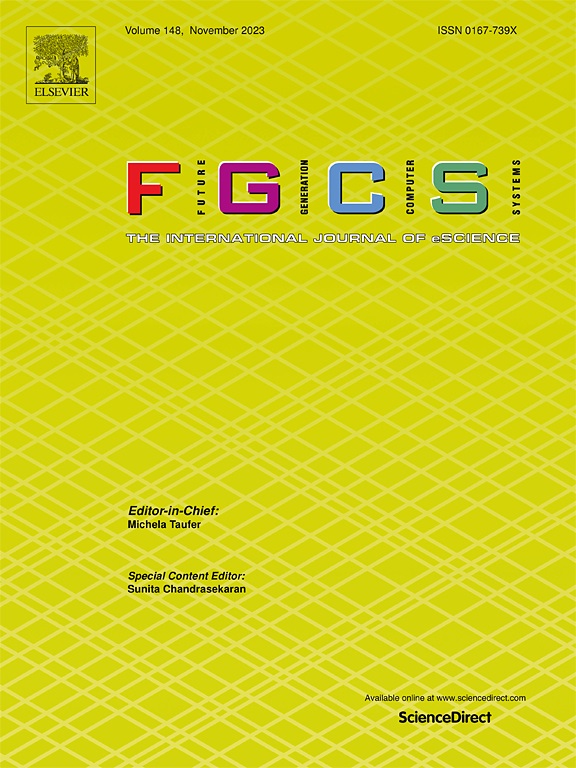DNA: Dual-radio Dual-constraint Node Activation scheduling for energy-efficient data dissemination in IoT
IF 6.2
2区 计算机科学
Q1 COMPUTER SCIENCE, THEORY & METHODS
Future Generation Computer Systems-The International Journal of Escience
Pub Date : 2025-02-11
DOI:10.1016/j.future.2025.107746
引用次数: 0
Abstract
With the fast expansion of the Internet of Things (IoT), a vast number of IoT gateways are being deployed and continuously disseminating data to proximate devices. As one of the most prevalent wireless technologies in our daily work and life, WiFi has been extensively used for data dissemination because of the widespread availability of WiFi infrastructures. However, data transmission over high-power WiFi can quickly deplete the batteries of IoT devices. Despite the introduction of numerous power saving protocols in WiFi-based IoT computer network systems, achieving both high energy efficiency and low delay remains a challenge due to the unpredictability of data traffic. To address this, we propose a dual-radio Dual-constraint Node Activation (DNA) scheduling scheme, which leverages an auxiliary low-power ZigBee radio to reactively activate the high-power WiFi radio for energy-efficient data dissemination. Besides the delay constraint required by WiFi upper-layer applications, the dual-radio energy optimization problem studied in this work is also limited by the constrained ZigBee bandwidth for performing radio activation. By jointly scheduling dual-radio duty cycles, DNA dynamically allocates ZigBee bandwidth to balance energy and delay for optimized system performance. Extensive real-world testing was conducted on a prototype dual-radio system equipped with off-the-shelf ZigBee and WiFi radios. Under medium bandwidth and delay constraints, DNA achieves an energy consumption of 7.95 mJ per data packet, which is 95.4% and 36.2% lower than the WiFi’s standard power saving protocol and a contemporary dual-radio scheduling scheme, respectively. Additionally, DNA has demonstrated superior reliability and adaptability in various scenarios.
DNA:物联网中节能数据传播的双无线电双约束节点激活调度
随着物联网(IoT)的快速发展,大量的物联网网关被部署,并不断向邻近设备传播数据。WiFi作为我们日常工作和生活中最普遍的无线技术之一,由于WiFi基础设施的广泛普及,WiFi被广泛用于数据传播。然而,通过高功率WiFi传输数据会迅速耗尽物联网设备的电池。尽管在基于wifi的物联网计算机网络系统中引入了许多节能协议,但由于数据流量的不可预测性,实现高能效和低延迟仍然是一个挑战。为了解决这个问题,我们提出了一种双无线电双约束节点激活(DNA)调度方案,该方案利用辅助的低功率ZigBee无线电来被动激活高功率WiFi无线电,以实现节能的数据传播。除了WiFi上层应用所需的延迟约束外,本研究的双无线电能量优化问题还受到ZigBee进行无线电激活的带宽约束的限制。DNA通过联合调度双无线电占空比,动态分配ZigBee带宽,平衡能量和延迟,优化系统性能。在配备现成的ZigBee和WiFi无线电的原型双无线电系统上进行了广泛的实际测试。在中等带宽和延迟约束下,DNA每个数据包的能耗为7.95 mJ,比WiFi的标准节能协议和当代双无线电调度方案分别低95.4%和36.2%。此外,DNA在各种情况下显示出优越的可靠性和适应性。
本文章由计算机程序翻译,如有差异,请以英文原文为准。
求助全文
约1分钟内获得全文
求助全文
来源期刊
CiteScore
19.90
自引率
2.70%
发文量
376
审稿时长
10.6 months
期刊介绍:
Computing infrastructures and systems are constantly evolving, resulting in increasingly complex and collaborative scientific applications. To cope with these advancements, there is a growing need for collaborative tools that can effectively map, control, and execute these applications.
Furthermore, with the explosion of Big Data, there is a requirement for innovative methods and infrastructures to collect, analyze, and derive meaningful insights from the vast amount of data generated. This necessitates the integration of computational and storage capabilities, databases, sensors, and human collaboration.
Future Generation Computer Systems aims to pioneer advancements in distributed systems, collaborative environments, high-performance computing, and Big Data analytics. It strives to stay at the forefront of developments in grids, clouds, and the Internet of Things (IoT) to effectively address the challenges posed by these wide-area, fully distributed sensing and computing systems.

 求助内容:
求助内容: 应助结果提醒方式:
应助结果提醒方式:


